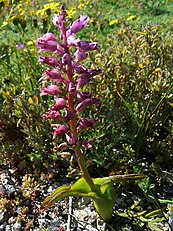Cape Columbine
32°49′39″S 17°51′23″E / 32.82750°S 17.85639°E

Cape Columbine is well known for its lighthouse, the last staffed lighthouse built on the South African coast. [1]. The Cape Columbine Lighthouse was commissioned on October 1, 1936. Both the headland and lighthouse derive their name from the barque Columbine, that was wrecked 1.5 km North of the lighthouse on March 31, 1829 [2].
South African lighthouse firsts
- First to receive three navigational aids: light, a fog signal and a radio beacon.
- First lens system designed for use with a 4 kW incandescent electric lamp.
Shipwrecks
Several ships were wrecked in the area, which is known for its multitude of submerged rocks and reefs.
- Columbine 1829
- Ismore 1899
- SS Saint Lawrence 1876
- SS Lisboa 1910
- SS Haddon Hall 1913
- SS Malmesbury 1930
- Haleric 1932
- Da Gama 1979
- SS Columbine 1944 (Torpedoed)
Climate
| Climate data for Cape Columbine (1991–2020 normals) | |||||||||||||
|---|---|---|---|---|---|---|---|---|---|---|---|---|---|
| Month | Jan | Feb | Mar | Apr | May | Jun | Jul | Aug | Sep | Oct | Nov | Dec | Year |
| Record high °C (°F) | 40.4 (104.7) |
37.5 (99.5) |
36.7 (98.1) |
36.0 (96.8) |
31.0 (87.8) |
27.8 (82.0) |
26.6 (79.9) |
30.1 (86.2) |
34.0 (93.2) |
33.2 (91.8) |
36.9 (98.4) |
37.2 (99.0) |
40.4 (104.7) |
| Mean daily maximum °C (°F) | 21.9 (71.4) |
22.3 (72.1) |
21.7 (71.1) |
21.1 (70.0) |
19.2 (66.6) |
17.5 (63.5) |
17.1 (62.8) |
17.1 (62.8) |
17.5 (63.5) |
19.4 (66.9) |
20.5 (68.9) |
21.7 (71.1) |
19.8 (67.6) |
| Daily mean °C (°F) | 17.9 (64.2) |
18.2 (64.8) |
17.6 (63.7) |
17.0 (62.6) |
15.7 (60.3) |
14.3 (57.7) |
13.8 (56.8) |
13.7 (56.7) |
14.2 (57.6) |
15.7 (60.3) |
16.6 (61.9) |
17.8 (64.0) |
16.0 (60.9) |
| Mean daily minimum °C (°F) | 13.9 (57.0) |
14.1 (57.4) |
13.7 (56.7) |
12.9 (55.2) |
12.2 (54.0) |
11.1 (52.0) |
10.5 (50.9) |
10.4 (50.7) |
11.0 (51.8) |
12.0 (53.6) |
12.8 (55.0) |
13.8 (56.8) |
12.4 (54.3) |
| Record low °C (°F) | 6.1 (43.0) |
8.3 (46.9) |
5.0 (41.0) |
6.0 (42.8) |
4.4 (39.9) |
3.9 (39.0) |
2.8 (37.0) |
4.4 (39.9) |
1.8 (35.2) |
3.3 (37.9) |
3.9 (39.0) |
5.0 (41.0) |
1.8 (35.2) |
| Average precipitation mm (inches) | 4 (0.2) |
6 (0.2) |
8 (0.3) |
21 (0.8) |
37 (1.5) |
46 (1.8) |
38 (1.5) |
35 (1.4) |
19 (0.7) |
14 (0.6) |
9 (0.4) |
7 (0.3) |
244 (9.6) |
| Average precipitation days (≥ 0.1 mm) | 2.2 | 2.2 | 3.1 | 5.5 | 8.2 | 8.8 | 9.2 | 9.1 | 7.0 | 5.8 | 3.5 | 2.8 | 67.4 |
| Average relative humidity (%) (at 14:00) | 74 | 74 | 75 | 76 | 77 | 76 | 76 | 76 | 75 | 74 | 74 | 75 | 75 |
| Source 1: Deutscher Wetterdienst (precipitation and humidity 1961–1990)[1] | |||||||||||||
| Source 2: Starlings Roost Weather[2] | |||||||||||||
Surrounds
The Columbine Nature Reserve surrounds Cape Columbine Lighthouse. On the southern side of the lighthouse is Tieties Bay (Afrikaans: Tietiesbaai). 5 km away is the fishing village of Paternoster. The coastline is well known for its sea life, especially for crawfish and abalone. Langebaan Lagoon, the West Coast National Park and a Fossil Park.


External links
References
- ^ "Klimatafel von Cape Columbine, Prov. Western Cape / Südafrika" (PDF). Baseline climate means (1961–1990) from stations all over the world (in German). Deutscher Wetterdienst. Retrieved 19 November 2016.
- ^ "CAPE COLUMBINE, SF Climate: 1991–2020". Starlings Roost Weather. Retrieved 27 December 2024.

- Along the West Coast of South Africa: Cape Columbine
- South African Department of Public Enterprises: LAUNCH OF THE SOUTH AFRICAN LIGHTHOUSE ADVENTURE TOUR OPERATIONS

